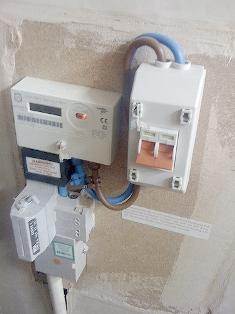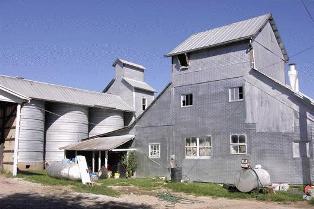Power supply design for farms
In the new conditions of a market economy, the land use policy that is being carried out is aimed at the broad development of farms with different specializations, family farms, the establishment of rental enterprises, the expansion of enterprises for primary processing and storage of agricultural products. In this regard, in the design of electrification systems for these facilities, new, simpler and more economical solutions for the distribution of electricity in rural areas, simplified compared to traditional three-phase, should be applied.
The introduction of high voltage is carried out with bare conductors, and the introduction of low voltage conductors from the power transformer to the low voltage switchgear and the outputs of 0.38 kV lines from the switchgear are carried out with insulated conductors. The substation equipment is protected from atmospheric overvoltage by 10 and 0.4 kV valve arresters installed on the 10 kV input and on the 0.4 kV busbars. The power transformer is protected by high voltage fuses.
 On the low voltage side, the substation circuit has two versions of multiphase short circuit protection. and overloading of outgoing lines 0.38 kV: automatic switches with current relay in the neutral wire and fuses with circuit breakers. Street lighting is controlled automatically (magnetic switch from the photo relay) or manually (packet switch).
On the low voltage side, the substation circuit has two versions of multiphase short circuit protection. and overloading of outgoing lines 0.38 kV: automatic switches with current relay in the neutral wire and fuses with circuit breakers. Street lighting is controlled automatically (magnetic switch from the photo relay) or manually (packet switch).
The entire distribution network (previously performed at 0.38 kV voltage) with a transit connection scheme is carried out entirely through a single disconnector at the end support of a 10 kV overhead line at the beginning of a group of substations. The power transformer and high voltage switchgear of the pole substation are served from the telescopic tower and the low voltage switchgear from the ground.
The proposed scheme envisages the installation of a 10 kV overhead line pad of three-phase power transformers up to 100 kVA with energy distribution at a voltage of 0.4 kV through the construction of short transmission lines without the construction of an 0.38 kV overhead line. This scheme also provides for the connection of single-phase transformers for powering small farms. In addition to single-phase loads, three-phase ones, for example asynchronous electric motors, can be connected to a single-phase network according to special connection schemes. This diagram represents a three-phase single-phase rural distribution system.
In the course of the technical and economic studies of the options for the power supply system in the traditional way (with HV 0.38 kV) and the proposed (without HV 0.38 kV), according to experts, it was established that the specific costs for the main building materials per 1 kVA with installed capacity are according to the new method: the consumption of concrete is reduced for the production of supports by 25%; the consumption of aluminum wires is reduced by 53%; the cost of steel for the production of substations is reduced by 36% and the cost of construction is reduced by 10%.
 These results show that a 0.38 kV three-phase single-phase power supply system for rural consumers without the construction of an overhead line is more efficient for farm electrification as well.
These results show that a 0.38 kV three-phase single-phase power supply system for rural consumers without the construction of an overhead line is more efficient for farm electrification as well.
The organization of farm electrification includes three stages: design, construction and installation works and technical operation of electrical installations.
A typical farm project has all the necessary data for the production of work on the installation of process electrical equipment and internal wiring. These works can be carried out independently by agricultural personnel with electrical education and professional experience, as well as carry out engineering calculations for the internal power supply of the facility, if it is built individually without using a standard project. The installation of internal wiring is carried out in strict accordance with the requirements PUE, PTB and PTE and other regulatory documents and technological equipment, in addition, in accordance with factory specifications and special agro- or zootechnical requirements.
External power supply between a particular farm and the nearest food source, usually individually.For the farmer, it is very important that the technical and constructive solution of the section for power supply through external power transmission networks is economically optimal.
When optimizing the external power supply, the areas of combinations of electrical loads of the economy and its distance from the power source are identified, considering several options for connecting to the electrical network, from which the optimal one is selected:
-
connection to the end or highway of the existing 0.38 kV overhead line passing through this settlement;
-
connection through a separately constructed overhead line 0.38 kV, fed from the existing transformer substation 10 / 0.4 kV without replacement or with replacement of the transformer with a higher power;
-
connection through the constructed 10 / 0.4 kV transformer substations and 10 kV overhead lines (possibly through the mixed three-phase single-phase distribution system discussed above) connected to the operational 10 kV overhead line closest to the farm or plot of the farmer.
An option of autonomous powering of a farm from small power plants can be considered if in a feasibility study it turns out to be optimal compared to power supply from a centralized power system, for example in the case of a significant distance to power grid facilities.

For farms, small and medium-sized enterprises, it is recommended to use diesel power plants with a nominal power of 8 ... 50 kW, and for remote and seasonal facilities, mobile three-phase AC units should also be used.It is recommended to use unified gasoline-electric units of the AB series with a voltage of 400 V, for example, AB-4-T400-M1 (TUOBA.516.022-73) - power 4 kW, weight 185 kg for individual yards.
Diesel power plants are equipped with three-phase synchronous generators with a zero point of the output, which provide direct start of asynchronous motors at idle with a power equal to 50 ... 70% of the nominal, allow 10% overload for 1 hour; 15% — 0.4 hours; 20% — 0.1 hours; 25% — 5 minutes; 40% — 3 minutes; 50% — 2 minutes; 100% — 1 min. Intervals between subsequent overloads must be at least 10 hours.
Diesel power plants are selected according to the total connected power of simultaneously operating electric receivers, which is determined for a maximum of half an hour in the time interval with the highest load, taking into account their average power factor. When creating a process schedule, the processes that must be fully preserved are considered first, then those that can be serviced in a limited power range. You should also aim to reduce the design load by reducing the power required for some processes, shifting certain processes to other times of the day, etc.
The electricity generated by the DPP must meet the following basic requirements: current frequency — at the level of 50 + -2 Hz at a power of 250 kW and 50 + -5 Hz — at a higher level, if energy consumers do not impose higher requirements; the voltage at the terminals of the electrical receiver should not exceed the permissible limits (10% — in complexes, poultry farms and large enterprises; 12.5% — in other agricultural enterprises). Continuous operation of the generator with an unbalanced phase load up to 25% of the nominal is allowed current, provided that this current does not exceed the nominal value in any of the network phases. The asymmetry of the mains voltage should not exceed 5 ... 10%.
In order to reduce the cost of agricultural products, it is necessary to reduce the consumption of electricity and energy for its production. Reducing the electrical intensity of products can be achieved by reducing technologically unjustified losses of electricity in electrical installations and using energy-saving technologies in production processes, including electrical technologies. Providing the necessary technological effect with lower energy consumption is achieved, for example, by using lamps, radiators and other special equipment for electrical equipment. Automation of production processes significantly saves energy, the introduction of which helps to automatically maintain a microclimate in livestock and cultivation facilities in optimal modes. The designs of electric boilers and heating devices existing today are widely used to meet the heat needs of farms of various sizes with sufficient productivity.
In terms of power supply reliability, farms belong users of category III.
Rastorguev V.M.
